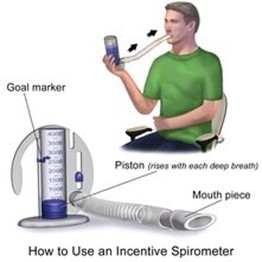MA is a 85 year old female who is admited to the hospital with Pneumonia. Education has begun on proper breathing techniques to expand lung volume as much as possible and allow for proper oxygen blood exchange within the alveoli. Which device will help her achieve this as educated by the nurse?
4L of oxygen via Nasal Cannula
Fluter Valve
Incentive Spirometer
Abdominal Binder
The Correct Answer is C
An Incentive Spirometer is a device that helps patients take deep breaths and improve their lung function. It encourages patients to take deep breaths and to hold them for a few seconds. The device also helps to monitor and measure lung volume. By using an incentive spirometer, MA can expand her lung volume as much as possible and allow for proper oxygen blood exchange within the alveoli. This is an important technique to help prevent pneumonia and other respiratory complications.
The other options mentioned, 4L of oxygen via Nasal Cannula, Fluter Valve, and Abdominal Binder, are not appropriate devices to help MA achieve proper breathing techniques and expand lung volume. 4L of oxygen via Nasal Cannula is used to provide supplemental oxygen to patients who have difficulty breathing. Fluter Valve is a handheld device used for airway clearance in patients with chronic obstructive pulmonary disease (COPD) or cystic fibrosis. An abdominal binder is a wrap that is placed around the abdomen to support the abdominal muscles and help reduce pain after surgery or injury. These devices do not help improve lung function and are not appropriate for MA's condition.

Nursing Test Bank
Naxlex Comprehensive Predictor Exams
Related Questions
Correct Answer is B
Explanation
Hyponatremia is a condition where the sodium levels in the blood are abnormally low. It can cause confusion, seizures, and even coma in severe cases. The IV fluids hanging are 0.33% NaCI, which means they have a low sodium concentration, and may be contributing to the patient's hyponatremia.
Given that the patient is becoming increasingly confused, it is important to assess his mental status and monitor him closely to prevent harm. However, restraining the patient should not be the first course of action. Instead, the nurse should focus on identifying the underlying cause of the hyponatremia and taking appropriate steps to address it.
Therefore, the next step would be to get an order for additional lab work to assess the patient's electrolyte levels and identify the cause of the hyponatremia. This will help to guide further treatment and management decisions for the patient.

Correct Answer is C
Explanation
An Incentive Spirometer is a device that helps patients take deep breaths and improve their lung function. It encourages patients to take deep breaths and to hold them for a few seconds. The device also helps to monitor and measure lung volume. By using an incentive spirometer, MA can expand her lung volume as much as possible and allow for proper oxygen blood exchange within the alveoli. This is an important technique to help prevent pneumonia and other respiratory complications.
The other options mentioned, 4L of oxygen via Nasal Cannula, Fluter Valve, and Abdominal Binder, are not appropriate devices to help MA achieve proper breathing techniques and expand lung volume. 4L of oxygen via Nasal Cannula is used to provide supplemental oxygen to patients who have difficulty breathing. Fluter Valve is a handheld device used for airway clearance in patients with chronic obstructive pulmonary disease (COPD) or cystic fibrosis. An abdominal binder is a wrap that is placed around the abdomen to support the abdominal muscles and help reduce pain after surgery or injury. These devices do not help improve lung function and are not appropriate for MA's condition.

Whether you are a student looking to ace your exams or a practicing nurse seeking to enhance your expertise , our nursing education contents will empower you with the confidence and competence to make a difference in the lives of patients and become a respected leader in the healthcare field.
Visit Naxlex, invest in your future and unlock endless possibilities with our unparalleled nursing education contents today
Report Wrong Answer on the Current Question
Do you disagree with the answer? If yes, what is your expected answer? Explain.
Kindly be descriptive with the issue you are facing.
